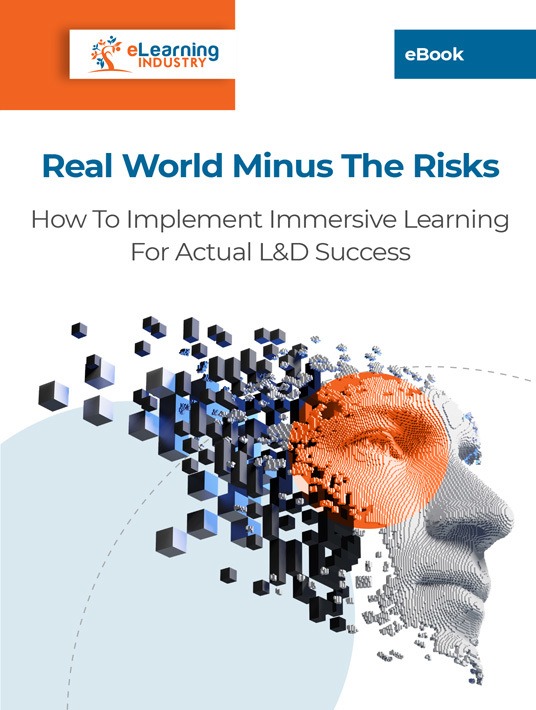Incorporate Immersive Learning Into Your Online Training Strategy
Employees must be able to think on their feet and resolve issues on the spot to keep customers content and build brand credibility. Making errors leads to valuable lessons, but at what cost? How can you encourage employees to be self-assured on the sales floor without throwing them into the proverbial deep end? The solution is immersive learning environments that instill confidence and prep them for every obstacle. They’ve seen it all before in virtual training activities, so they’re ready for anything that comes their way. Even if it involves difficult customers, coworker conflicts, or compliance risks. Here are 8 reasons to consider immersive learning for your employee online training strategy.

1. Mistakes Minus The Risk
Some of the most valuable lessons are learned from mistakes. Making errors uncovers hidden areas for improvement or sheds light on a hidden strength. Mistakes give us experiences that lead to personal growth. The only catch is that they often result in real-world repercussions that negatively impact your organization. Immersive learning environments allow employees to stumble and find better approaches without risk. However, AR and VR scenarios and simulations still show them what they have to lose—or gain—based on their performance in the workplace.
2. Reduce Compliance Violations
Some of the costliest mistakes pertain to compliance violations. Staffers breach company policy or don’t know how to follow rules and regulations. This leads to fines, penalties, and decreased brand credibility. Mixed Reality training immerses them in compliance challenges so they can test their response and build vital skills. For example, a VR simulation may involve a difficult customer who keeps pushing for a discount. How does the employee handle the situation without breaking company policies or offending the loyal consumer? Immersive learning is also ideal for dangerous tasks or protocols because employees can experience cause and effect. What happens if they don’t wear the right gear or mishandle the product?
3. Improve Online Training Participants' Engagement
Employees are more likely to engage in online training if it’s relevant, personal, and relatable. What is immersive learning? It’s an individualized approach that allows everyone to take something different from the experience. They’re living through the obstacle or task in the Virtual Training Environment. Thus, they can assign their own meaning and tackle personal gaps that stand in the way of fulfilling their potential. They’re more motivated to learn because it resonates with them and gives them the chance to focus on their pain points.
4. Instill Self-Confidence
Self-confidence, assurance, and reliance are difficult to teach. Employees need to build vital online training experiences to do their job effectively and perform at the top of their game. Immersive learning encourages them to face their weak points and challenge personal assumptions or beliefs that limit their abilities. They are more confident at work because VR and AR expose them to workplace stressors so that they’re fully prepared. Even if the event is in a different context.
5. Build Crucial Work Skills
Skills are a valuable asset, but many talents are hard to hone in formal online training settings. For example, you can’t necessarily teach interpersonal skills through presentations or quizzes. Employee training participants must uncover the many nuances of nonverbal communication and how to handle coworker conflicts without overstepping boundaries. Immersive learning allows them to explore social dynamics by interacting with personas to see how they might resolve a disagreement or master the meaning behind facial expressions.
6. Identify Hidden Gaps
One of the most convincing reasons to implement immersive learning in online training is to facilitate personal reflection. Employee training participants engage in simulations, games, and interactive scenarios to evaluate their own flaws discreetly. They can also watch demo videos to see the right and wrong way to apply soft skills. Then they analyze their past performance to identify areas for improvement. Virtual Training Environments allow for greater self-discovery because there aren’t any distractions to stand in the way. Employees emotionally connect with the online training experience and are able to assess behaviors and habits objectively.
7. Boost Customer Service And Sales
Customers also benefit from employee VR and AR training because staffers are better equipped to identify their needs, resolve issues by finding the right product, and treat them with respect. Thus, immersive learning improves customer satisfaction, loyalty, and overall sales. Employee training participants can pitch products because they know all the features and selling points. They can handle customer complaints with ease and identify their needs. This brings in more repeat business and improves your market reach.
8. Identify Limiting Cognition And Habits
Most of us find it difficult to admit that we can’t do it all. Immersive learning enables employees to evaluate their beliefs, cognition, and habits to continually develop their talents. They may discover that they’ve been performing a task incorrectly for weeks. Or that they lack a niche skillset that will help them boost workplace productivity. They have the opportunity to disclose underlying issues that negatively impact their job duties. For instance, a coworker misinformed them regarding a company policy. It’s a simple misunderstanding that could lead to serious repercussions, such as fees or penalties that affect your company’s bottom line.
What is immersive learning? It isn’t about over-the-top simulations or branching scenarios that put you over budget. Or demo videos with paid actors and dazzling special effects. You can still achieve the online training objectives on a tight budget by repurposing assets and keeping the design simple. Focus on a niche topic or task to reduce costs and help employees accomplish their goals. You should also consider outsourcing to tap into eLearning professionals' expertise, insights, and advanced eLearning authoring tools.
A Mixed Reality training strategy doesn’t have to drain your organization’s resources or make you go over budget. Download the eBook Real World Minus The Risks: How To Implement Immersive Learning For Actual L&D Success, and discover how you can benefit from incorporating immersive learning into your online training program. Provide an engaging training experience and boost your employees’ confidence with a Mixed Reality training solution.

